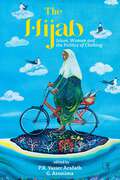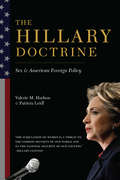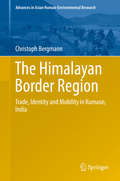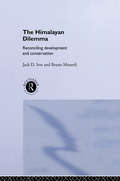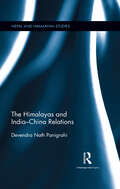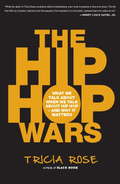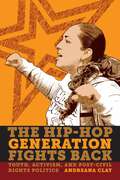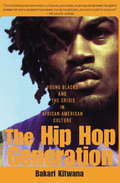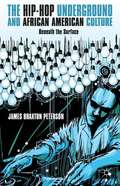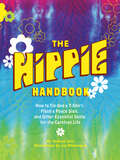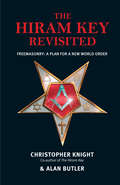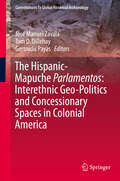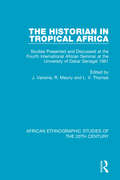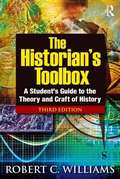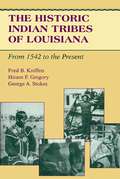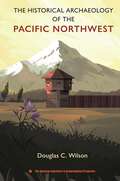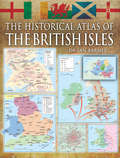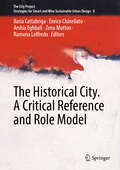- Table View
- List View
The Hijab: Islam, Women and the Politics of Clothing
by PK Yasser Arafath G ArunimaHistorically, in India, we have instances of both unveiling and veiling that have been initiated by Indian Muslim women. The early 20th century saw many Muslim women joining the national movement, giving up veiling, feeling this was the only way for them to change their own, and the country's, future. Almost a hundred years later, the hijab continues to be a bone of contention in India, though in very different ways. On one hand, the rape threats that hijabi/non-hijabi women frequently encounter in the cyber world reflect the extreme desperation of the aggravated Hindutva millennials who are made to believe that unveiling Muslim women is their right while a large segment of Indian Muslim women are increasingly convinced that wearing the hijab is their constitutional prerogative. This collection of essays, primarily from India but also with a couple from Bangladesh and Iran, complicates the relationship between Muslim women and the hijab. Moving away from predictable interpretations that see the hijab merely as an instrument of Muslim women&’s oppression, the essays here, from a variety of perspectives including historical, ethnographic, and political, demonstrate that not only have Muslim women covered/ or uncovered their heads for different reasons, but the head cloth itself has had different forms depending on the region or period of history. The essays track the reasons why clothing, especially women&’s attire, is very often a site of contestation and provide ways to hear and understand the ways in which Muslim girls or women make their own sartorial choices. They also offer ways of interpreting the stakes in banning the hijab in different parts of the world, and the implications of the ban on Muslim women, the wider community and the very idea of citizenship itself.
The Hillary Doctrine
by Swanee Hunt Valerie M. Hudson Patricia LeidlHillary Rodham Clinton is the first Secretary of State to declare the subjugation of women worldwide a serious threat to U.S. national security. Known as the Hillary Doctrine, her stance was made part of the 2010 Quadrennial Diplomatic and Development Review of U.S. foreign policy, formally committing America to the proposition that the empowerment of women is a stabilizing force for domestic and international peace.Blending history, fieldwork, theory, and policy analysis while incorporating perspectives from officials and activists on the front lines of implementation, this is the first book to thoroughly investigate the Hillary Doctrine in principle and practice. Does the insecurity of women make nations less secure? How has the doctrine changed the foreign policy of the United States and altered its relationship with other countries, such as China and Mexico? With specific studies of Guatemala, Afghanistan, Saudi Arabia, and Yemen, this invaluable policy text closes the gap between rhetoric and reality, confronting head-on what the future of fighting such an entrenched enemy entails. It reports directly on the work being done by U.S. government agencies, including the Office of Global Women's Issues, established by Clinton during her tenure at the State Department, and explores the complexity and pitfalls of attempting to improve the lives of women while safeguarding the national interest.
The Hillary Doctrine: Sex and American Foreign Policy
by Patricia Leidl Valerie HudsonHillary Rodham Clinton was the first Secretary of State to declare the subjugation of women worldwide a serious threat to U.S. national security. Known as the Hillary Doctrine, her stance was the impetus behind the 2010 Quadrennial Diplomatic and Development Review of U.S. foreign policy, formally committing America to the proposition that the empowerment of women is a stabilizing force for domestic and international peace.Blending history, fieldwork, theory, and policy analysis while incorporating perspectives from officials and activists on the front lines of implementation, this book is the first to thoroughly investigate the Hillary Doctrine in principle and practice. Does the insecurity of women make nations less secure? How has the doctrine changed the foreign policy of the United States and altered its relationship with other countries such as China and Saudi Arabia? With studies focusing on Guatemala, Afghanistan, and Yemen, this invaluable policy text closes the gap between rhetoric and reality, confronting head-on what the future of fighting such an entrenched enemy entails. The research reports directly on the work being done by U.S. government agencies, including the Office of Global Women's Issues, established by Clinton during her tenure at the State Department, and explores the complexity and pitfalls of attempting to improve the lives of women while safeguarding the national interest.
The Himalayan Border Region
by Christoph BergmannDrawing fromextensive archival work and long-term ethnographic research, this book focuseson the so-called Bhotiyas, former trans-Himalayan traders and a Scheduled Tribeof India who reside in several high valleys of the Kumaon Himalaya. The area islocated in the border triangle between India, the Tibet Autonomous Region (TAR,People's Republic of China), and Nepal, where contestations over politicalboundaries have created multiple challenges as well as opportunities for localmountain communities. Basedon an analytical framework that is grounded in and contributes to recentadvances in the field of border studies, the author explores how theBhotiyas have used their agency to developa flourishing trans-Himalayan trade under British colonial influence; to assertan identity and win legal recognition as a tribal community in the politicalsetup of independent India; and to innovate their pastoral mobility in thecontext of ongoing state and market reforms. By examining theBhotiyas' trade, identity and mobility thisbook shows how and why the Himalayan border region has evolved as an agentive siteof political action for a variety of different actors.
The Himalayan Dilemma: Reconciling Development and Conservation
by Jack D. Ives Bruno Messerli`This is an important book that deserves to be read by everyone concerned with presenting major environmental issues.' Geography` ... an essential text for policy makers and aid professionals, as well as for students of environmental studies and international development ... It is indeed, a book appropriate to the urgent and critical issues which it addresses.' - Journal of Environmental Management
The Himalayas and India-China Relations (Nepal and Himalayan Studies)
by Devendra Nath PanigrahiThis book provides a systematic analysis of China's rise to power. It traces the complex contours of its relation with India, with the Himalayas prominently figuring in the discourse. Drawing on myths, legends, classical literature, archival resources and contemporary political and international affairs, it brings to the fore several critical issues integral to India–China relations. It also studies the two nations in terms of trade across borders, exchange of ideas and confluence of diverse cultures, imperial strategic rivalries in the colonial period, and recent military skirmishes and diplomatic interaction. Lucid and explanatory, this volume will interest scholars and researchers in international relations, history, political science and area studies specially those interested in the geopolitics of India and China.
The Hindu Family and the Emergence of Modern India
by Eleanor NewbiginBetween 1955 and 1956 the Government of India passed four Hindu Law Acts to reform and codify Hindu family law. Scholars have understood these acts as a response to growing concern about women's rights but, in a powerful re-reading of their history, this book traces the origins of the Hindu law reform project to changes in the political-economy of late colonial rule. The Hindu Family and the Emergence of Modern India considers how questions regarding family structure, property rights and gender relations contributed to the development of representative politics, and how in solving these questions, India's secular and state power structures were consequently drawn into a complex and unique relationship with Hindu law. In this comprehensive and illuminating resource for scholars and students, Newbigin demonstrates the significance of gender and economy to the history of twentieth-century democratic government, as it emerged in India, and beyond.
The Hip Hop Wars: What We Talk About When We Talk About Hip Hop--and Why It Matters
by Tricia RoseHip-hop is in crisis. For the past dozen years, the most commercially successful hip-hop has become increasingly saturated with caricatures of black gangstas, thugs, pimps, and 'hos. The controversy surrounding hip-hop is worth attending to and examining with a critical eye because, as scholar and cultural critic Tricia Rose argues, hip-hop has become a primary means by which we talk about race in the United States.In The Hip-Hop Wars, Rose explores the most crucial issues underlying the polarized claims on each side of the debate: Does hip-hop cause violence, or merely reflect a violent ghetto culture? Is hip-hop sexist, or are its detractors simply anti-sex? Does the portrayal of black culture in hip-hop undermine black advancement?A potent exploration of a divisive and important subject, The Hip-Hop Wars concludes with a call for the regalvanization of the progressive and creative heart of hip-hop. What Rose calls for is not a sanitized vision of the form, but one that more accurately reflects a much richer space of culture, politics, anger, and yes, sex, than the current ubiquitous images in sound and video currently provide.
The Hip-Hop Generation Fights Back: Youth, Activism and Post-Civil Rights Politics
by Andreana ClayFrom youth violence, to the impact of high stakes educational testing, to editorial hand wringing over the moral failures ofhip-hop culture, young people of color are often portrayed as gang affiliated, “troubled,” and ultimately, dangerous. The Hip-Hop Generation Fights Back examines how youth activism has emerged to address the persistent inequalities that affect urban youth of color. Andreana Clay provides a detailed account of the strategies that youth activists use to frame their social justice agendas and organize in their local communities.Based on two years of fieldwork with youth affiliated with two non-profit organizations in Oakland, California, The Hip-Hop Generation Fights Back shows how youth integrate the history of social movement activism of the 1960s, popular culture strategies like hip-hop and spoken word, as well as their experiences in the contemporary urban landscape, to mobilize their peers. Ultimately, Clay’s comparison of the two youth organizations and their participants expands our understandings of youth culture, social movements, popular culture, and race and ethnic relations.
The Hip-Hop Generation: Young Blacks and the Crisis in African-American Culture
by KitwanaThe Hip Hop Generation is an eloquent testament for black youth culture at the turn of the century. The only in-depth study of the first generation to grow up in post-segregation America, it combines culture and politics into a pivotal work in American studies. Bakari Kitwana, one of black America's sharpest young critics, offers a sobering look at this generation's disproportionate social and political troubles, and celebrates the activism and politics that may herald the beginning of a new phase of African-American empowerment.
The Hip-hop Underground And African American Culture
by James Braxton PetersonThe underground is a multi-faceted concept in African American culture. Peterson uses Richard Wright, KRS-One, Thelonius Monk, and the tradition of the Underground Railroad to explore the manifestations and the attributes of the underground within the context of a more panoramic picture of African American expressivity within hip-hop.
The Hippie Handbook: How to Tie-Dye a T-Shirt, Flash a Peace Sign, and Other Essential Skills for the Carefree Life
by Chelsea CainA groovy guide to hippie culture from the New York Times–bestselling author.Brothers and sisters! Here at last is a light-hearted, free-spirited, groovy guide to the timeless hippie skills and activities that make the world a better place, one macrame belt at a time. In illustrated, easy-to-follow instructions, author Chelsea Cain—who grew up on an Iowa hippie commune—provides practical and playful know-how for the hippie and hippie-at-heart. Learn how to milk a goat, build a compost pile, play “Kumbaya” on the guitar, teach a dog how to catch a Frisbee, and get your file from the FBI. Discover the finer points of caring for a fern, choosing a mantra, organizing a protest, naming your hippie baby, and making sand candles as holiday gifts. Including primers on cooking, dressing, driving, telling time, dancing, and celebrating your birthday in classic hippie style, and a righteous appendix of essential hippie books, movies, and slang, The Hippie Handbook knows the score. Right on.“Run us cheerily through the basics of the hippie lifestyle and beyond.” —January Magazine
The Hiram Key Revisited: Freemasonry: A Plan For a New World Order
by Alan Butler Christopher KnightA comprehensive and compelling account of the secret society that has shaped world events—and its ongoing influence today.Freemasonry, with its arcane rituals, occult symbols, and labyrinthine hierarchy, has mystified the outside world for centuries. But today, even the most senior Freemasons do not understand its ancient origins or purpose. So what is this powerful and arcane organization really for?In this eye-opening account, two seasoned researchers show that today’s Freemasons are the spiritual descendants of an ancient priesthood that was forced to act in secrecy. They predicted the birth of Jesus Christ, who was part of their mission. Soon after the Crucifixion they were nearly wiped out in a genocide conducted by the Romans. Later, in feudal Europe, they grew to a position of unparalleled power before being branded as heretics and forced underground. Yet despite this adversity, they continued to work in subtle, anonymous ways to pursue their objective—a new world order that put God above, and yet out of, human affairs.
The Hispanic Republican: The Shaping of an American Political Identity, from Nixon to Trump
by Geraldo L. CadavaAn illuminating and thought-provoking history of the growth of Hispanic American Republican voters in the past half century and their surprising impact on US politics, updated with new material reflecting on the 2020 electionIn the lead-up to every election cycle, pundits predict that Latino Americans will overwhelmingly vote in favor of the Democratic candidate. And it’s true—Latino voters do tilt Democratic. Hillary Clinton won the Latino vote in a “landslide,” Barack Obama “crushed” Mitt Romney among Latino voters in his reelection, and, four years earlier, the Democratic ticket beat the McCain-Palin ticket by a margin of more than two to one. But those numbers belie a more complicated picture. Because of decades of investment and political courtship, as well as a nuanced and varied cultural identity, the Republican party has had a much longer and stronger bond with Hispanics. How is this possible for a party so associated with draconian immigration and racial policies?In The Hispanic Republican, historian and political commentator Geraldo Cadava illuminates the history of the millions of Hispanic Republicans who, since the 1960s, have had a significant impact on national politics. Intertwining the little understood history of Hispanic Americans with a cultural study of how post–World War II Republican politicians actively courted the Hispanic vote during the Cold War (especially Cuban émigrés) and during periods of major strife in Central America (especially during Iran-Contra), Cadava offers insight into the complicated dynamic between Latino liberalism and conservatism, which, when studied together, shine a crucial light on a rapidly changing demographic that will impact American elections for years to come.
The Hispanic-Mapuche Parlamentos: Interethnic Geo-politics And Concessionary Spaces In Colonial America (Contributions To Global Historical Archaeology)
by Tom D. Dillehay José Manuel Zavala Gertrudis PayàsAnthropological histories and historical geographies of colonialism both have examined the material and discursive processes of colonization and have identified the opportunities for different kinds of relationships to emerge between Europeans and the indigenous people they encountered and in different ways colonized. These studies have revealed complex, differentiated, colonializing and colonialized identities, shifting and ambiguous political relations, social pluralities, and mutating and distinctive modes of colonization. This book focuses on the complementary historical, linguistic, and archaeological evidence for indigenous resistance and resilience in the specific form of parlamento political negotiations or attempted treaties between the Spanish Crown and the Araucanians in south-central Chile from the late 1600s to the early 1800s. Armed conflict, the rejection of most Spanish material culture, and the use of the indigenous Mapundungun language at parlamentos were obvious forms of Araucanian resistance. From a bigger picture, the book is based on an interdisciplinary perspective and asserts that historical archeology can provide better interpretations of past societies only if combined with other disciplines experienced by the treatment of existing data for historical periods, such as those provided by the written documents and which can be subjected to an anthropological, ethnohistorical, and linguistic reading by these disciplines. This creates tension because complementarity but also requires a questioning of the methods themselves as an offset look in order to include the other disciplinary perspectives.
The Historian as Detective: Essays on Evidence
by Robin W. WinksThe adventurous search for clues to scholarly hoaxes, forgeries, and lost and misleading documents, and the evaluation of evidence in man's study of his own past.
The Historian in Tropical Africa: Studies Presented and Discussed at the Fourth International African Seminar at the University of Dakar, Senegal 1961
by J. Vansina, R. Mauny and L. V. ThomasOriginally published in 1964 these papers discuss the recovery and critical interpretation of oral traditions and written documents, problems of dating and analysis of material from archaeological sites, the use of linguistic evidence, and methods of historical reconstruction concerning techniques, art styles and changes in social organization. Consideration is also given to wider problems concerning the pre-colonial history of certain parts of Africa. Attitudes towards the study and understanding of various aspects of historical develoment both among scholars and the public are also reviewed.
The Historian's Toolbox: A Student's Guide To The Theory And Craft Of History
by Robert C. WilliamsWritten in an engaging and entertaining style, this widely-used how-to guide introduces readers to the theory, craft, and methods of history and provides a series of tools to help them research and understand the past. Part I is a stimulating, philosophical introduction to the key elements of history--evidence, narrative, and judgment--that explores how the study and concepts of history have evolved over the centuries. Part II guides readers through the workshop of history. Unlocking the historian's toolbox, the chapters here describe the tricks of the trade, with concrete examples of how to do history. The tools include documents, primary and secondary sources, maps, arguments, bibliographies, chronologies, and many others. This section also covers professional ethics and controversial issues, such as plagiarism, historical hoaxes, and conspiracy theories. Part III addresses the relevance of the study of history in today's fast-paced world. The chapters here will resonate with a new generation of readers: on everyday history, oral history, material culture, public history, event analysis, and historical research on the Internet. This Part also includes two new chapters for this edition. "GIS and CSI" examines the use of geographic information systems and the science of forensics in discovering and seeing the patterns of the past. "Too Much Information" treats the issue of information overload, glut, fatigue, and anxiety, while giving the reader meaningful signals that can benefit the study and craft of history. A new epilogue for this edition argues for the persistence of history as a useful and critically important way to understand the world despite the information deluge.
The Historic Indian Tribes of Louisiana: From 1542 to the Present Louisiana
by Fred B. Kniffen Hiram F. Gregory George A. StokesAlthough many specialized studies have been written about Louisiana's Indian tribes, no complete account has appeared regarding their long, varied history. The Historic Indian Tribes of Louisiana: From 1542 to the Present is a highly informative study that reconstructs the history and cultural evolution of these people. This study identifies tribal groups, charts their migrations within the state, and discusses their languages and customs. According to the authors, the first descriptions of Louisiana Indians are contained in accounts kept by members of Hernando de Soto's expedition In the 1540s. The next recorders of Indian life were the French in the 1700s. European influences irrevocably marked the Indians' lives. The natives lost tribal lands to the new settlers and replaced many of their weapons and tools with those of the Europeans. Diseases apparently introduced by the Spaniards decimated entire tribes and caused the disappearance of certain tribal languages that had never been recorded. However, much of Indian material culture has survived even to the present, including the dugout canoe, or pirogue, and the beautiful cane basketry of the Chitimacha tribe.According to the authors, current figures show that Louisiana has the third largest native American population in the eastern United States. Several of Louisiana's present-day Indian tribes, such as the Tunica-Biloxi, Choctaw, and Koasati, entered the state in the second half of the eighteenth century. They gradually established settlements throughout the state, at times displacing the native tribes. Today, many of Louisiana's Indians work in business and industry and as farmers and loggers.The Historic Indian Tribes of Louisiana is a valuable contribution to the literature on Louisiana History. It will be of interest to anthropologists, geographers, historians, and anyone wanting to know more about these important members of Louisiana's population.
The Historic Unfulfilled Promise
by Howard Zinn Mathew RothschildHoward Zinn's life and work are the stuff of legend. His People's History of the United States has sold over two million copies and has altered how we see and teach history. A hero in word and deed, Zinn's views on freedom, fairness, history, democracy, and our own human potential are educational and transformative. In few places is the genius of his voice more crystallized and accessible than in the dozens of articles he penned for The Progressive magazine from 1980 to 2009, offered together here in book form for the first time. Whether critiquing the Barack Obama White House, the sorry state of US government and politics, the tragic futility of US military actions in Afghanistan and Iraq, or the plight of working people in an economy rigged to benefit the rich and powerful, Zinn's historical clarity, unflappable optimism, and unshakable questions reverberate throughout The Historic Unfulfilled Promise: "Have our political leaders gone mad?" "What kind of country do we want to live in?" "What is national security?" "Do we have a right to occupy a country when the people of that country obviously do not want us there?" "Is not war itself terrorism?" "Should we not begin to consider all children, everywhere, as our own?" "Has the will of the people been followed?" The Historic Unfulfilled Promise is a genuine work of conscience, rich in ideas, charged with energy; an invaluable introduction for the uninitiated and a must-have for Zinn's fans.
The Historical Archaeology of the Pacific Northwest (The American Experience in Archaeological Perspective)
by Douglas C. WilsonHow archaeology illuminates the confluence of people, places, and events that shaped the Pacific Northwest Bordered by the Rocky Mountains to the east and the Pacific Ocean to the west, the Pacific Northwest—including Oregon, Washington, Idaho, and British Columbia—is home to a diverse range of people and cultures whose history is closely tied to the natural environment. In this book, Douglas Wilson uses historical documents, Indigenous oral traditions, and the material record to provide a comprehensive overview of the region’s historical archaeology from the seventeenth through the twenty-first centuries. The book covers Lewis and Clark’s Fort Clatsop; fur trade forts such as Fort Vancouver, Fort Langley, and Fort Nez Percés; Indigenous villages such as Middle Village and Yuquot; the Christian mission at Waiilatpu; the Oregon Trail; the settler town of Champoeg; and military locations including Fort Lane, San Juan Island, and Fork Hoskins. Wilson describes how extractive industries like fishing, mining, logging, and fur trapping transformed the environment and the human population. He also discusses transportation, urban development, racism, and government policies through the Great Depression and World War II. Central to the story of the American experience in the Pacific Northwest is the heritage and history of local Indigenous peoples, as well as descendant communities of European, African, Asian, and Pacific Islands ancestry. Wilson shows how material artifacts and landscapes can be compared with the documentary record to critically examine colonial and nationalistic narratives, illuminating the past and present of Indigenous peoples and immigrant groups in the region. A volume in the series the American Experience in Archaeological Perspective, edited by Michael S. Nassaney and Krysta Ryzewski
The Historical Atlas of the British Isles
by Dr. Ian BarnesA visual history of the many peoples who&’ve inhabited and shaped Britain, from hunter-gatherers to Celts, Vikings, Normans, and modern immigrants. This atlas covers the history of the British Isles from earliest times to the present day. The first hunter-gatherers, who crossed into what would become the United Kingdom by the land-bridge, and later followed by more familiar peoples the Celts, Angles, Saxons, Vikings, and Normans, who together would create Britain&’s unique history. Each of these groups contributed ideas that shaped the lands, languages, and thoughts at the core of British identity. This story is illustrated with 150 full-color maps and plans that range across many topics, such as agricultural, political, and industrial revolutions. The expansion of the islands&’ peoples across the oceans left a lasting legacy on the world, and on Britain itself. The book shows the fluctuating fortunes of the states by which Britain currently identifies itself, from an Anglo-Scottish imperium to devolved power, independence, and the often-painful process by which the modern map evolved. The forces of history and religion have often divided the islands&’ peoples, but DNA unites them much more than most would realize as they continue to embrace new cultures arriving in search of refuge, opportunity, and equality.
The Historical City. A Critical Reference and Role Model (The City Project #8)
by Ilaria Cattabriga Enrico Chinellato Arshia Eghbali Zeno Mutton Ramona LoffredoThis book offers a multivocal and interdisciplinary arena that brings together a wide range of thoughts and approaches addressing the intricacies of dealing with the historical city today. Spanning across a multitude of humanistic, sociological, and technological outlooks, it provides a multifaceted overview of current research on the city and its historicity. Based on revised and extended contributions presented at two international conferences, namely “The Historical City as a Critical Reference and Role Model for Innovative Urban and Metropolitan Development” (January 26-27, 2023) and “The Historical City as a Field for Critical Exercise. Criticism, Politics, Actors (April 17, 2023), both held at the University of Bologna, this book is an insightful and thought-provoking read for researchers in Architecture, History, Urban Studies, Social Sciences, and the Arts, as well as professionals and policy makers dealing with historical cities.
The Historical Consumer
by Janet Hunter Penelope FrancksThis book explores the rise of consumerism and the expanding variety of goods available in Japan. Japan is placed within the comparative context of the 'consumer revolution' in Europe and North America, contributing to the analysis of the ways in which consumption and everyday life change in the course of economic development.
The Historical Formation of the Arab Nation: A Study In Identity And Consciousness (Routledge Library Editions: The Arab Nation)
by A A DuriThis book is a comprehensive examination of the historical process of social formation that gave rise to the communal consciousness of the Arab nation and determined its sense of identity. It aims to provide a historical context for the assessment of prevailing concepts and suggests hypotheses for the development of modern Arab consciousness. The book firstly traces Arab origins and the formation of Arab societies after the emergence of Islam, assessing the perspectives and factors that shaped the rise of the Arab nation in both practical and intellectual terms. It then examines the beginning of the Arab awakening and the course of its development in the latter half of the nineteenth century and the first two decades of the twentieth, focusing on the emergence of a nationalist perspective in the development of intellectual positions on patriotism and Arabism.
